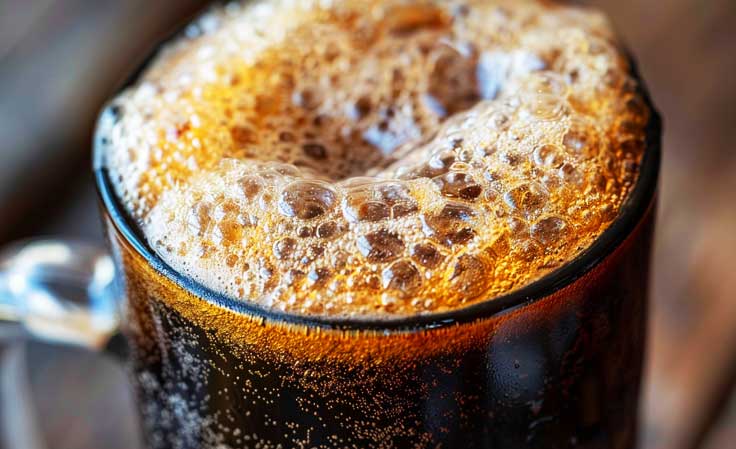Summer is right around the corner, and I am itching to get barbequing and enjoying dinners out in the yard. One drink I love to have for events (and for myself) is root beer.
I don’t drink soda from the store because when you look at the ingredients, you will oftentimes find questionable coloring and high fructose corn syrup.
While carbonation is refreshing during hot days, caramel coloring is not. So how do you enjoy soda while avoiding toxic ingredients? You make it yourself!
Root beer holds a special place in my heart because I think of the root beer floats I would make at family events. But what if I told you there's a way to take this beloved beverage to the next level?
Enter fermented root beer – a tantalizing twist on the classic soda that adds depth of flavor and potential health benefits through the magic of fermentation.
I have been enjoying fermented foods after discovering the long list of health benefits they have to offer—including fermented root beer!
Fermented Root Beer
Root beer, with its unique blend of herbs, spices, and botanicals, has been enjoyed for centuries as a refreshing and nostalgic beverage. Traditionally, root beer was made by brewing a concoction of roots, barks, and spices, which was then sweetened and carbonated.
That is where the word “root” in root beer stems from—the roots originally used in brewing this beverage. Over the years, root beer became polluted with ingredients that are far from actual roots, barks, and spices.
However, with the rise of home fermentation enthusiasts (myself included,) a new trend has emerged – fermented root beer.

The Fermentation Process
Fermentation is the process by which microorganisms such as yeast and bacteria convert sugars into alcohol and carbon dioxide. If you have a sourdough starter, you will be familiar with how a sourdough starter takes in local yeasts and bacteria to facilitate the fermentation process.
In the case of fermented root beer, a similar process happens. Wild yeast and beneficial bacteria present in the environment or introduced through a starter culture initiate fermentation, result in a naturally carbonated and mildly alcoholic beverage.
Ingredients Used in Fermented Root Beer
Traditional root beer recipes often include a combination of sassafras root, sarsaparilla, wintergreen, licorice, and other botanicals. In fermented root beer, these ingredients serve as the foundation for flavor, but additional sugar and water are added to provide fermentable sugars for the yeast and bacteria.
Isn’t it neat that we can create beloved beverages, naturally?
Modern variations of fermented root beer may incorporate additional ingredients such as fruits, herbs, and spices to enhance flavor complexity and create unique taste profiles. These variations allow for creativity and experimentation, making each batch of fermented root beer a truly one-of-a-kind creation.
Flavor preference varies between individuals and families, so you can experiment with different spices and herbs to see what you like the most! You may not even enjoy the taste of root beer from the store, but you may end up liking your own homemade root beer.
Health Benefits of Fermented Root Beer
Beyond its delicious taste, fermented root beer offers potential health benefits thanks to its probiotic content. During the fermentation process, beneficial bacteria, such as Lactobacillus and Bifidobacterium, proliferate in the root beer.
These probiotic microorganisms are known to support gut health by balancing the microbiome, promoting the growth of beneficial bacteria, and inhibiting the growth of harmful pathogens. Our gut is under constant strain when we burden it with environmental toxins.
Processed foods, antibiotics, and alcohol can damage our gut health. Consuming fermented root beer instead of other processed drinks may contribute to a healthy digestive system and improve overall gut function.
Additionally, fermented beverages like root beer may contain trace amounts of vitamins and minerals derived from the fermentation process, further enhancing their nutritional value. We are depleted of vitamins and minerals, especially if we are relying on foods fortified with them.
Fermented foods are extremely beneficial when it comes to gut health, and it is a good idea to incorporate them into your diet where you can. What I love about fermented root beer is that it is fun to make and beneficial to drink! Who says fermented foods can’t be a source of fun?!
How to Make Fermented Root Beer
Making fermented root beer at home is a rewarding and relatively straightforward process. I know it may sound daunting to make homemade soda, but don’t be nervous about it.
To start, you'll need a combination of roots, barks, and spices for flavor, as well as sugar, water, and a starter culture of yeast and bacteria.
Water kefir grains consume sucrose and molasses. This makes it the sweetest among fermented beverages, making it an ideal choice for brewing your own homemade fermented sodas.
Begin by simmering the roots, barks, and spices in water to extract their flavors and medicinal properties. Next, sweeten the liquid with sugar and allow it to cool to room temperature.
Once cooled, add the starter culture of yeast and bacteria, then transfer the mixture to glass bottles and seal them tightly. The yeast and bacteria will consume the sugar as food, so it is important not to miss that step.
The bottles are then left to ferment at room temperature for several days to a week, depending on desired flavor intensity and carbonation level. During fermentation, the yeast and bacteria consume the sugars in the liquid, producing carbon dioxide and alcohol as byproducts.
This process naturally carbonates the root beer and gives it its characteristic flavor. Again, you can adjust the taste with the different spices and barks you use.
Fermented Root Beer Variations
One of the joys of making fermented root beer is the opportunity to experiment with different flavors and ingredients. While traditional recipes adhere to a specific blend of roots and spices, modern variations allow for creativity and customization.
Typically, the root beers at the store have been chemically processed in big batches. Because this is small-batch homebrewing, you have a lot more control over the process and outcome.
For example, you can infuse your root beer with fruits such as berries, citrus, or stone fruits for added sweetness and complexity. Herbs and botanicals like mint, lavender, or ginger can impart refreshing and aromatic notes.
If you have an herb garden, this is a fun way to utilize the different herbs in your garden. The possibilities are endless, allowing you to tailor your fermented root beer to suit your taste preferences and culinary imagination.
I love infusing my fermented root beer with a hint of orange citrus, and I go heavy on spices like cinnamon. Reminds me of childhood holidays in a bottle!
Serving and Enjoying Fermented Root Beer
Once fermentation is complete, fermented root beer can be enjoyed straight from the bottle or poured over ice for a refreshing treat. It pairs well with grilled meats, sandwiches, and other picnic fare, making it a perfect beverage for outdoor gatherings and cookouts.
This is why it is the perfect beverage for summer. If you have a neighborhood party, your neighbors and friends won’t believe the delicious carbonated drink that you have is beneficial for their guts too!
For a fun twist, try using fermented root beer as a base for cocktails or mocktails. Mix it with fruit juices, herbs, and spirits for a flavorful and fizzy concoction that's sure to impress your guests.
Common Misconceptions About Fermented Root Beer
Despite its growing popularity, fermented root beer is not without its misconceptions. One common concern is the alcohol content, as fermentation naturally produces trace amounts of alcohol.
However, the alcohol content in homemade fermented root beer is typically low, comparable to that of kombucha or non-alcoholic beer. As always, it's essential to consume fermented beverages responsibly and in moderation. You can discuss with your healthcare provider if you have any concerns.
Another misconception is that fermented root beer is difficult or complicated to make at home. While fermentation does require some patience and attention to detail, it's a rewarding and accessible process that anyone can learn with practice.
Fermentation is easy to do at home! With the right ingredients, equipment, and guidance, you can create delicious fermented root beer in the comfort of your own kitchen. This is an easy homemade root beer recipe. If I can do it, so can you!

Fermented Root Beer
Equipment
Ingredients
- 1/4 cup sassafras root bark
- 2 tbsp sarsaparilla root
- 1 tbsp wintergreen leaf
- 1 tbsp licorice root
- 1 cinnamon stick
- 1 vanilla bean, split
- 1 cup granulated sugar
- 1/4 cup molasses
- 1/4 tsp active dry yeast
- water
Instructions
- In a large pot, combine the sassafras root bark, sarsaparilla root, wintergreen leaf, licorice root, cinnamon stick, and vanilla bean. Add 1 gallon of water and bring to a boil. Reduce heat and simmer for 20 minutes.
- Remove the pot from the heat and stir in the granulated sugar and molasses until dissolved. Allow the mixture to cool to room temperature.
- Once cooled, strain the liquid through a fine mesh sieve or cheesecloth into a clean container. Discard the solids.
- Sprinkle the active dry yeast over the surface of the liquid and gently stir to combine. Transfer the liquid to glass bottles, leaving at least 1 inch of headspace at the top.
- Seal the bottles with the swing-top lids and allow them to ferment at room temperature for 3-5 days, or until carbonated to your liking. Burp the bottles daily to release excess carbonation.
- Once fermented, refrigerate the root beer to halt the fermentation process. Serve chilled and enjoy!
I think that you will absolutely love making homemade fermented soda! You have probably heard how unhealthy traditional sodas are and how hard it is to stop drinking them.
Well, you don’t have to entirely kick the habit if you brew your own soda at home with beneficial and herbs and spices. Fermented foods are stellar for gut health, so you can enjoy your carbonated beverage and reap the benefits too!
Frequently Asked Questions (FAQs)
1. Does fermented root beer contain alcohol?
While fermented root beer may contain trace amounts of alcohol due to the fermentation process, the alcohol content is typically low and comparable to that of non-alcoholic beverages like kombucha. If you are concerned, consult with your medical doctor.
2. Can I make fermented root beer without a starter culture?
While a starter culture of yeast and bacteria can help initiate fermentation and ensure consistent results, it is possible to ferment root beer using naturally occurring microorganisms present in the environment. However, using a starter culture can help control the fermentation process and produce a more predictable outcome. Water kefir grains are preferred to use for homebrewed soda.
3. How long does it take to ferment root beer?
The fermentation time for root beer can vary depending on factors such as temperature, sugar content, and desired flavor intensity. In general, fermentation can take anywhere from a few days to a week or more.
4. Is fermented root beer safe to drink?
When made following proper fermentation techniques and hygiene practices, fermented root beer is safe to drink. However, it's essential to monitor the fermentation process closely and discard any batches that exhibit signs of contamination or spoilage.
5. Can I adjust the sweetness and carbonation level of fermented root beer?
Yes, you can adjust the sweetness and carbonation level of fermented root beer to suit your taste preferences. During fermentation, you can taste the root beer periodically and adjust the sugar and fermentation time accordingly to achieve the desired balance of sweetness and carbonation. I prefer sweeter, so I add in more sugar.
